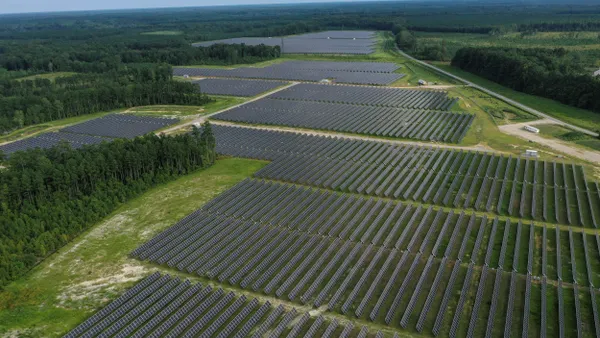Dive Brief:
- The rush to install solar before the 30% federal investment tax credit (ITC) reverts to its pre-2006 10% levels at the end of 2016 has sparked a backlog of orders for modules and inverters that could slow solar growth, ECT reports.
- The shortage is causing scheduling difficulties for electric cooperatives developing utility-scale and community solar projects with average delivery times set at six months from large manufacturers and distributors, and could be fully booked for 2016 by early December.
- The National Association of Rural Electric Cooperatives urged members to place 2016 solar hardware orders before the year’s end.
Dive Insight:
The bottleneck in orders has birthed concern from 14 electric cooperatives participating in the Department of Energy-sponsored Solar Utility Network Deployment Acceleration (SUNDA) project, which aims to increase co-op deployment of solar.
If the U.S. Congress doesn't extend the ITC, it will drop to 10% for commercial solar investments and zero for residential solar investments in January 2017. Such a concern has pushed installers and customers to throw up solar panels before the tax credit sunsets, which is causing a backlog for orders and might depress growth in the solar sector.
For the co-ops and DOE program, the backlog could hurt the co-ops. The program developed a standardized development package of engineering designs, business models, financing and insurance options and optimized procurement. The goal: Cut engineering design costs 25%, consolidated procurement costs 10%, and insurance costs 25% and bring the total installed cost down to $1.60 per watt.
Some solar analysts believe reversion of the ITC will compromise the value proposition of utility scale solar, though many co-op projects would not be affected because they are not taxed. With aggressive parameters and a 30% ITC, modeling produced a levelized PPA price of about $43 per MWh.
But if the ITC isn't extended and reverts to its original 10% credit, the PPA price is increased only to about $54 per MWh, according to Mark Bolinger, a Lawrence Berkeley National Laboratory scientist.
Bolinger recently told Utility Dive that “there have been a lot of contracts signed at that level, and it is not clear to me demand will suddenly dry up if we go back to a 10% ITC in 2017.”














